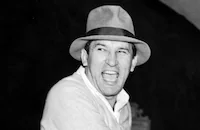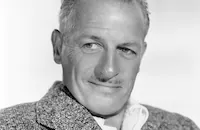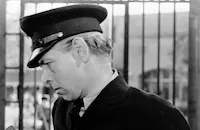Love Letters

Brief Synopsis
Cast & Crew
William Dieterle
Jennifer Jones
Joseph Cotten
Ann Richards
Cecil Kellaway
Gladys Cooper
Film Details
Technical Specs

Synopsis
During World War II, while on the Allied front in Italy, Alan Quinton writes love letters to Victoria Remington for fellow British officer Roger Morland, who met her briefly at a ball. Victoria falls in love with the poetic spirit behind the letters, and although Alan is engaged to Helen Wentworth, he too falls in love with Victoria through her letters. Roger and Victoria marry, and when Alan is wounded, Roger visits his parents in England while on his honeymoon. Alan finally returns home and stays in a sanitorium while he recuperates, and soon learns that Roger has died in an accident. At the end of the war, Alan has difficulty returning to civilian life, and is eager to move to Beltmarsh to a country house he has inherited from an aunt. Before leaving London, Alan's brother takes him to a party where he meets Dilly Carson and a woman named Singleton. While drunk, Alan tells the story of how he lost his heart to a woman he never met, but to whom he wrote for another man. Dilly realizes that Alan is speaking of Victoria and Roger, and tells him that an "old murder" was committed at Beltmarsh, and that he should think about the letters while he is there. Shortly after moving to Beltmarsh, which is still looked after by his aunt's caretaker, Mack, Alan breaks his engagement to Helen. One day, Alan goes to Meadow Farm, Victoria's former home, but is told that Victoria died over a year earlier. Recalling Dilly's words, he researches newspaper articles at the library and learns that Roger was murdered by his wife. Alan feels somehow responsible for Roger's death, and goes to see Dilly in London. There he encounters the amnesiac Victoria, who now goes by the name of Singleton, the name given to her as a child at an orphanage. Dilly warns Alan not to tell Victoria the truth of who he is, and explains that she was a Canadian orphan adopted by Beatrice Remington. Although she only met Roger briefly, Victoria fell in love with him through the letters, and married him, despite Beatrice's protests, only three days after he returned from the front. Dilly then recalls the past: Victoria grows sullen after marrying, and one day, Dilly is called to Meadow Farm, where she finds Roger stabbed to death, Victoria completely dazed, and Beatrice suffering from a paralytic stroke. Because Beatrice cannot testify at the murder trial, Victoria confesses her guilt, but admits she cannot remember anything about her past. After spending one year in a prison psychiatric ward, Victoria is released into the care of her old friend Dilly. Dilly now tells Alan that Beatrice has recovered and is living in a nursing home, but that Victoria has never recovered her memory, and does not even know her real name, believing that she is "Singleton." One day, Victoria unexpectedly appears at Beltmarsh, and she and Alan fall in love. Because Victoria is unaware of her own identity, she still believes that he is in love with another woman named Victoria Morland. Alan and Victoria marry, but she is plagued by her own erratic recollections and Alan's love of the "other woman." One day, while Alan is away, Victoria intercepts a letter from Beatrice telling Alan that she has moved back to Meadow Farm. Victoria goes back to her old house, where the murder took place, and Beatrice recounts the story of Victoria's marriage: Victoria becomes depressed because Roger does not share her sentimental nature. Realizing Victoria is in love with the writer of the letters rather than him, the callous Roger soon becomes abusive. One day, while drunk, he tells Victoria that he did not write the letters and burns them, then beats Victoria as she tries to pull them from the fire. Beatrice, who has an obsessive need to protect Victoria, stabs Roger to death, then has a paralytic stroke. When Victoria, who crouches by the fireplace grieving over the loss of her letters, suddenly realizes that Roger is dead, she picks up the knife, incriminating herself, then lapses into amnesia. When Alan arrives at the house, Victoria recalls her true identity. Although Beatrice tries to persuade Victoria that they should hate the man who wrote the letters, Victoria runs to Alan, who confesses that it was he. Finally, they embrace.

Director

William Dieterle
Cast

Jennifer Jones

Joseph Cotten

Ann Richards

Cecil Kellaway

Gladys Cooper

Anita Louise
Robert Sully

Reginald Denny

Ernest Cossart
Byron [s.] Barr

James Millican
Lumsden Hare
Winifred Harris
Ethel May Halls
Matthew Boulton
David Clyde

Ian Wolfe
Alec Craig

Arthur Hohl
Conrad Binyon
Nina Borget

Louise Currie
Mary Field
Connie Leon
George Humbert
Clifford Brooke
Constance Purdy
Ottola Nesmith
Helena Grant
Catherine Craig
Harry Allen
Anthony Marsh
Crew
Roland Anderson
Anne Bauchens
Sam Comer
Dr. Montfort F. Creves
Hans Dreier
Farciot Edouart
Lee Garmes
Loyal Griggs
Edith Head
Eddie Heyman
Gordon Jennings
Don Johnson
Paul Lerpae
Don Mckay
Richard Mcwhorter
Ray Moyer
Helen Gladys Percey
Ayn Rand
Dorothy Robinson
Geoffrey Steele Lieut. R.a.r.o., The Royal Dragoons
Victor Stoloff
Harry Webb
Wally Westmore
Philip G. Wisdom
Victor Young
Victor Young

Photo Collections
Videos
Trailer
Hosted Intro
Film Details
Technical Specs

Award Nominations
Best Actress
Best Art Direction
Best Score
Best Song
Articles
Love Letters (1945)
This variation on the "Cyrano" story was written for the screen by Ayn Rand, who adapted Chris Massie's novel Pity My Simplicity. Rand had not written a screenplay at this point, though her play Night of Jan. 16th had been filmed in 1941, and her novel We the Living was made into an Italian film in 1942. Love Letters producer Hal Wallis hired Rand to write two scripts at the same time; You Came Along (1945) was the other, and it opened in theaters a month before Love Letters. Rand's most famous novel, The Fountainhead, would reach screens in 1949.
This was one of the first movies Hal Wallis produced after leaving Warner Bros. for Paramount in 1944. He originally envisioned Gregory Peck to star opposite Jones, but Peck felt Love Letters, with its amnesia theme, was too similar to his just-completed Spellbound (1945). Wallis decided to go with Joseph Cotten instead and got in touch with David Selznick, to whom both Cotten and Jones were under contract. Selznick agreed to the loan-outs under several conditions: that Selznick retain approval of Jones's hair, makeup and costumes; that Jones receive top billing over Cotten; that Jones be paid $100,000, a big sum in those days; and that shooting be wrapped by Jan. 1, 1945, so that Jones would be ready to start filming Duel in the Sun (1946). Even after Wallis agreed, Selznick never stopped bothering him with further memos and notes, "as if Love Letters were Selznick's movie." (Bernard Dick, Hal Wallis).
The hassle was worth it. Love Letters was a success and Jones received her third of four consecutive Oscar® nominations. (She lost to Joan Crawford in Mildred Pierce.) She would receive a fifth nomination a decade later. Love Letters also captured nominations for Best Score, Best Song, and Best Black-and-White Art Direction.
Love Letters was shot by the great Lee Garmes, whose expressive and moody cinematography greatly enhances the romantic feel of the picture. Garmes later recalled in Charles Higham's book Hollywood Cameramen: "On Love Letters I used the same method I used on Guest in the House (1944). I created an artificial landscape: clouds, trees, everything were in the studio. Dieterle, the director, used to go home every night and have dinner, and afterwards he'd have a little tiny set at home which he'd put the actors on in the shape of tiny dried-up peas. He'd move them around to prepare the next day's shooting."
William Dieterle was a freelance director at this point. He had built his career at Warner Brothers in the 1930s, directing many prestige pictures there under Hal Wallis - films like The Life of Emile Zola (1937) and Juarez (1939). He had a reputation as a sadist on the set and always wore white gloves to work. Nonetheless he coaxed a fine performance out of Jennifer Jones and would direct her again in Duel in the Sun and Portrait of Jennie (1948), both of which also co-starred Joseph Cotten. The two stars would team up for five pictures in all.
Producer: Hal B. Wallis
Director: William Dieterle
Screenplay: Ayn Rand, Christopher Massie
Cinematography: Lee Garmes
Film Editing: Anne Bauchens
Art Direction: Roland Anderson, Hans Dreier
Music: Victor Young
Cast: Jennifer Jones (Singleton/Victoria Morland), Joseph Cotten (Allen Quinton), Ann Richards (Dilly Carson), Cecil Kellaway (Mac), Gladys Cooper (Beatrice Remington), Anita Louise (Helen Wentworth).
BW-101m.
by Jeremy Arnold

Love Letters (1945)
Quotes
Call her... a pin-up girl of the spirit.- Allen Quinton
I couldn't possibly say what I'd like to say right now.- Allen Quinton
What?- Singleton
I'd like to say that you're lovely.- Allen Quinton
Go ahead, say it. I'd like to hear it.- Singelton
You're lovely.- Allen Quinton
I think very few people are happy. They wait all their lives for something to happen to them - something great and wonderful. They don't know what it is but they wait for it. Sometimes it never happens. What they want is the kind of spirit I found in those letters. A spirit that makes life beautiful. I love that man. I loved him more than my own life. I still love him. So you see, I couldn't have loved Roger Moreland, the man I killed.- Singleton
Trivia
Notes
This film's working title was The Love Letters. The film was copyrighted twice, on June 5, 1945 at a length of 11 reels, and on October 26, 1945 at a length of 9 reels. No information has been found to clarify the discrepancy in the length, however, and the released film was 9 reels. Hollywood Reporter news items noted that Lizabeth Scott was tested for a role in the picture, and that Derek Cooper was to make his feature film debut. Cooper's appearance in the final film has not been confirmed. The film was nominated for Academy Awards in the categories of Best Actress, Best Art Direction, Best Interior Decoration, Best Music and Best Song. Although the song "Love Letters" was nominated for an Academy Award, it was not heard in the viewed print of the film.


















